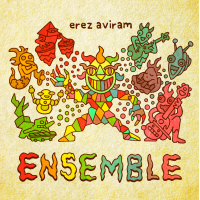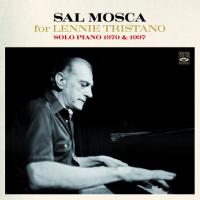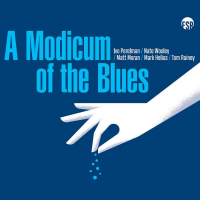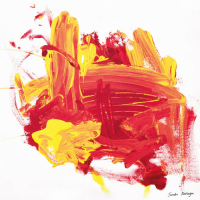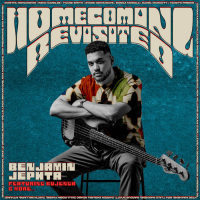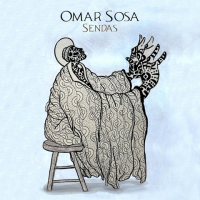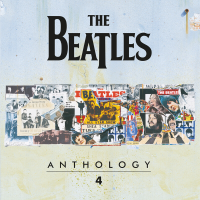Home » Jazz Articles » Album Review » Mat Maneri & Randy Peterson: Light Trigger
Mat Maneri & Randy Peterson: Light Trigger
Perhaps the closest precedent to this recording would be the stunning hatOLOGY CD So What? (1999) with Matthew Shipp, or either of the two equally stunning Leo CDs by the Mat Maneri Trio, where the duo is joined by veteran Jazz bassist Ed Schuller. The absence of Schuller, however, leads to a profoundly different musical experience, as the extensive rhythmic and harmonic repertoire that Schuller has internalized during his distinguished career performing mostly Jazz-based music ensures that the trio always has at least one toe in familiar territory, whereas the duo doesn't even venture into the same zip code as anything one might call familiar, unless "familiar" means previous Maneri/Peterson recordings. The interpretation of Wayne Shorter's "Orbits" (from Miles Davis' Miles Smiles ) could fairly be considered an exception to this generalization, although it doesn't jump out in stark contrast with the rest of the album in the same way that the 2 interpretations of Ornette Coleman's "Tone Dialing" do on the Trio's most recent recording, Fifty-one Sorrows. Perhaps the most important distinction to be drawn between this duo recording and the work of the Trio is a methodological one, however. Quite simply, Light Trigger is mostly (but not exclusively) free improvisation, while the Trio makes far more extensive use of pre-composed material in combination with highly adventurous improvisation. In this respect, the duo is closer to the Joe Maneri Quartet, which essentially draws on the previous experience of the Quartet instead of written themes. In terms of gross structure, though, the duo's music differs from both the Trio and the Quartet in that the latter two groups frequently subdivide into various solos, duos and trios during a performance, while the duo stays a duo for the entirety of Light Trigger ; there are no viola solos and there are no drum solos (except for a brief one on the more conventionally arranged "Orbits".) This is part of the magic of this recording: a genuine example of 'two voices as one'
Four of the cuts on So What? (recorded at roughly the same time as Light Trigger : summer, 1998) are Miles Davis interpretations, but the other five cuts are Maneri originals that feature a lot of the idiosyncratic twists and turns that are taken to an extreme on this duo disc. Matthew Shipp's dense romanticism has supplied the listening world with a great deal of fantastic music, but on So What? he is forced to adapt himself to the more abstract musical universe inhabited by Maneri and Peterson, with incredibly successful results that are strikingly different to Shipp's duo work with Maneri. The difference, of course, is Randy Peterson. Maneri by himself is an immensely flexible musician who can blend with Shipp to make rich music that draws equally on the familiar melodic fragments favored by Shipp and the inscrutable inventions favored by Maneri, as witnessed on their beautiful hatOLOGY recording Gravitational Systems. When Maneri gets together with Peterson, though, he has a chance to speak a musical language so robust that Shipp is swallowed in its depths, resulting in one of Shipp's most surprising performances. It is this Maneri/Peterson language that is spoken with unabashed confidence and fluency on Light Trigger. There is nothing quite like a conversation between two native speakers.
Maneri and Peterson have had an intimate performing relationship for some 12 years, but I would hesitate to say that they 'breathe together' simply because the contours of this music are so remote from anything as cyclic and regular as a biological system like human breathing. I don't think a wind instrument would ever make music quite like this (although Mats Gustafsson should be noted in this connection.) Indeed, Mat Maneri and Randy Peterson have not only drunk deeply of elder Joe Maneri's innovations, but they have also poured a pretty hefty pitcher of their own. On Light Trigger we find arms and legs fighting feverishly to transgress the laws of biology. Maneri doesn't simply play phrases on the viola; he sets off volatile explosions of note-fragments. Likewise, Peterson doesn't reach some sort of climax every few measures; he reaches 5 or 10 on every beat. The funny part, though, is that the duo somehow always maintains a 'pulse'; damned if I knew how they do it, but it's unmistakable. Maybe it has something to do with Peterson's acknowledged debt to Tony Williams, even though you might never guess it unless he told you. Actually, sometimes I do hear Williams in the tense and very brief episodes of almost evenly spaced emphatic cymbal hits that crop up now and then in Peterson's playing, but this might just be my imagination.
More generally, this is music which rewards at the microscopic level. There is an attention to sonic detail that evokes the spirit of Morton Feldman; Maneri gives us a peek into the hidden world of bow and string in the same way that Rohan De Saram imparts a new shade of meaning every time he plays the 'same' note on his cello in Feldman's "Patterns In A Chromatic Field" (hat ART 2-6145). Of course, Maneri and Peterson average several orders of magnitude more notes per minute than Feldman at his most extroverted, but this only makes the subtlety in their playing that much more remarkable.
The resonance between Feldman and Maneri/Peterson goes further than this, though. Feldman (and also John Cage) often spoke of a desire to present a sequence of sounds where each sound is freed from associations with what precedes and follows. In retrospect, we can understand that this is an impossible goal, but, in seeking to realize it, Feldman provided us with a new concept of foreground and background in music. Specifically, in Feldman's music we often hear events that last on the order of seconds. This 'event structure' is only possible if there is a means of marking boundaries; events have beginnings and endings. Typically by means of silence, Feldman foregrounds certain sounds so that we can treat them as a unit that can be viewed from more than one angle before being replaced by the next unit. This opportunity to re-hear the same musical event while it is happening is also provided by Maneri/Peterson on Light Trigger. Sometimes the duo even uses pauses in a way not completely dissimilar to some of Feldman's work. We find this especially on "Appear", "Sunned", and "Cradle". It should be noted, though, that many of the pauses in Maneri and Peterson's playing are not marking boundaries ala Feldman, but rather serving as escape routes for the rapid build-up of energy that precedes them, hence becoming part of the same event as what precedes them, rather than a space between events. It is as though the pair creates so much momentum that they can no longer continue, and the sounds they have made lurch into the silence, where they dissipate in time for the next attack. In contrast, Feldman's events always have a heat sink built-in.
Silence is certainly not the only way to demarcate musical events, and the other means deployed by the duo constitute perhaps the most revelatory aspect of their work. Maneri and Peterson play a music with more dynamic variation than anything else I've ever heard, and this is not variation over a large time-scale, like the build-to-a-climax approach used so often in improvised music, but variation within the space of a single moment. The sudden dynamic shifts that constantly appear in these improvisations give suggestions to the listener about where the boundaries of events might be placed. Perhaps this is not that much different from the conventional practice of accenting certain beats to suggest a regular way of grouping notes, but with Maneri and Peterson the size and shape of the groups seem to change from one note to the next. Ultimately, the most exciting thing about their approach to dynamics is that they never lose sight of the smallest details, allowing the listener to construct multiple interpretations. In my personal experience listening to music, I feel that the highest degree of engagement occurs when these multiple interpretations are experienced at the same time. This opportunity seems present most often in the music of master improvisers because the exigencies of the moment tend to evoke interactions of much greater complexity than would result from the necessarily simpler interactions prescribed by a score. When left to its own storehouse of associations, the brain of a sensitive musician like Maneri or Peterson can deliver more information to the listener than any external informational medium like a score. More information means more ways of organizing that information, and hence greater involvement on the part of the listener. Just as with a recording by Parker/Guy/Lytton, each playback of Light Trigger reveals shocking new layers of structure as the listener sorts through the dense web of possibilities. Density and space may seem like antagonists, but the surgically precise dynamics of these improvisations create a rare context in which these two phenomena can co-exist unproblematically. Indeed, it sometimes seems mysterious that Peterson's playing is filled with so many pregnant spaces when he is usually producing a constant flurry of notes. I would submit that it is his new concept of dynamic variation that makes such a mysterious state of affairs a palpable reality.
It was Feldman himself who claimed to be exploring "...discontinuity as an aspect of a new type of continuity..." and the above remarks certainly paint Maneri and Peterson as fellow explorers. Despite the obvious differences between Feldman and Maneri/Peterson in terms of both method and content, I can't help but to speculate that if Morton Feldman were alive today to hear this music, he might well become an enthusiastic advocate of the possibilities of improvisation rather than an ambivalent non-practitioner.
It is worth taking a moment to discuss the unique approach to pitch relationships adopted by Maneri in this music. As has been noted many times elsewhere, Mat has absorbed the microtonal wisdom of his father Joe Maneri, and the absence of a microtonally-challenged instrument like piano or guitar (as wielded by frequent collaborator Joe Morris) gives him free rein to indulge in a type of musical exploration that is still in its infancy. No doubt also in connection with his father's influence, Mat often bases his improvisations on 12 tone rows that could hardly be considered reassuring to most Jazz listeners. Speaking in general, there is lack of familiar licks in his playing that really focuses attention on the more sublime elements of this music. One might even be tempted to see a kinship with the non-referential solipsism of Elliott Carter, and Mat's acknowledged interest in his music suggests that this may be more real than imagined.
Turning our attention to extra-musical aspects of this CD release, the liner notes by poet Steve Dalachinsky are among the best I've ever read. Dalachinsky's intimacy with words (as documented on his excellent Knitting Factory CD Incomplete Directions, consisting of poetry with improvised music accompaniment by various folks including Mat Maneri) enables him to take successful liberties in attempting to pay textual tribute to the successful liberties taken by Maneri and Peterson in the music itself. A few personal highlights include "...strictly controlled accidents...", "...this ecstatically somber dance...", "the deepest funk tail wagging at the world with distrustful admiration...", and the powerfully concise "...violint drum...". Recommended reading (but please not at the same time as listening to the CD.)
As if a CD full of incendiary and delicate improvisations together with superb liner notes was not enough, we are also treated to two stunning paintings on the front and back covers of the liner notes. Both works are by Vanessa Clark and feature a thick, yet sharply defined swath of black on either a yellow or red background, giving a visual rendition of the oblique shards of energy that penetrate Maneri and Peterson's musical canvas. Just like the music, Clark's paintings have an intense and unified visceral impact while also offering abundant detail. This is truly a rare case of album artwork matching the music, even to the extent of the vertical orientation of the black columns in the paintings, which seem to correspond to the manner in which Maneri and Peterson's 3D music events subdue the horizontal flow of time, building upwards and sideways instead of just forwards.
Mat Maneri: viola Randy Peterson: drums
1. Of It's Own Kind (Maneri/Peterson) 7:17 2. Sunned (Maneri) 4:59 3. Partched Throat Watanabe (Maneri) 5:56 4. Orbits (Wayne Shorter) 4:50 5. Cradle (Maneri/Peterson) 6:33 6. Flailing Off (Maneri/Peterson) 3:00 7. Light Trigger (Maneri) 1:56 8. Appear (Maneri/Peterson) 7:13 9. Funk Tail (Maneri/Peterson) 3:41 10. Straight Burn (Maneri) 7:21 11. Untitled (Maneri/Peterson) 5:02
No More Records can be contacted via email with: [email protected]
This review appears courtesy of the Italian website ( Musicboom )
Personnel
Mat Maneri
violaAlbum information
Title: Light Trigger | Year Released: 2000 | Record Label: No More Records
Tags
PREVIOUS / NEXT
Support All About Jazz
 All About Jazz has been a pillar of jazz since 1995, championing it as an art form and, more importantly, supporting the musicians who make it. Our enduring commitment has made "AAJ" one of the most culturally important websites of its kind, read by hundreds of thousands of fans, musicians and industry figures every month.
All About Jazz has been a pillar of jazz since 1995, championing it as an art form and, more importantly, supporting the musicians who make it. Our enduring commitment has made "AAJ" one of the most culturally important websites of its kind, read by hundreds of thousands of fans, musicians and industry figures every month.












